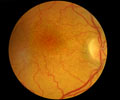A noninvasive ground-breaking tool that detects signs of disease at early molecular stages before symptoms can be seen using traditional methods is described in new research published in the May 2010 print issue of The FASEB Journal (http://www.fasebj.org).
Even better, this tool promises to detect some eye diseases so early that they may be reversed before any permanent damage can occur. Its use may well extend to other areas of the body in the future, and this tool may also give physicians a more precise way of evaluating the effectiveness of therapies."Quantitative knowledge of the dynamic molecular changes in health and disease will not only advance our understanding, but also change the way medicine will be practiced in the future," said Ali Hafezi-Moghadam, M.D., Ph.D., co-author of the study from the Massachusetts Eye and Ear Infirmary, Department of Ophthalmology at Harvard Medical School in Boston.
To make this discovery, Hafezi-Moghadam and colleagues combined fluorescent microspheres with molecules found on the surface of immune cells. These molecules are up-regulated early in inflammation. The scientists took this compound and combined it once more with custom-designed imaging probes. Then they used both single- and double-combined probes targeting endothelial markers in the eyes of test animals because of the eye's unique accessibility to light-based imaging. Results showed a strikingly superior sensitivity of the double-conjugated probes that allowed detection of molecules that may be expressed at very low levels, which occurs in many diseases. The imaging probes also detected activated immune cells, leading to unprecedented quantitative knowledge about immune response to disease.
"This tool is a total game-changer: it detects inflammatory eye disease at the molecular level before damage occurs," said Gerald Weissmann, M.D., Editor-in-Chief of The FASEB Journal, "Once you have symptoms, it may be too late. By then, doctors are often limited to damage control. Now in the eye, and later in other areas of the body, early detection of molecular changes by fluorescent microspheres will save lives. It should certainly change people's expectations of when treatment is indicated."
Source-Eurekalert
RAS














